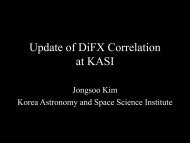The Allen Telescope Array Twenty-centimeter Survey—A - CIRA
The Allen Telescope Array Twenty-centimeter Survey—A - CIRA
The Allen Telescope Array Twenty-centimeter Survey—A - CIRA
You also want an ePaper? Increase the reach of your titles
YUMPU automatically turns print PDFs into web optimized ePapers that Google loves.
– 13 –<br />
without some averaging of the input visibilities (which risks degradation of image quality).<br />
4.3. Mosaicking<br />
We made a linear mosaic of the 243 individual primary-beam corrected images, masking<br />
each outside a radius corresponding to the nominal half-power points (75 ′ ), in order to avoid<br />
exaggerating the effects of the deviation of the true primary beam from a Gaussian at large<br />
distances from the pointing center (in particular, the 10% sidelobes; Harp et al. 2010).<br />
<strong>The</strong> final image was transformed to a GLS (global sinusoid) geometry, which has the<br />
property that each pixel subtends an equal area on the sky. This is important for an image<br />
coveringsuchalargearea,sincethecurvatureoftheskyintroducesdistortions. Inprojections<br />
that do not preserve area, the size of the beam would change across the mosaic, resulting in<br />
errors in the integrated flux densities reported by the source fitting procedure. If we were<br />
not to perform this transformation on the ATATS mosaic, we would bias the flux densities<br />
of the sources low by around ∼ 2%, and increase the scatter in the measured flux densities<br />
by ∼ 12% when compared to NVSS.<br />
<strong>The</strong> RMS noise in this final 12-epoch image, which we term the “master mosaic”, is<br />
3.94mJy beam −1 . <strong>The</strong> dynamic range, determined by dividing the peak flux density of the<br />
brighest source in our map (4.14Jy) by the RMS noise in a 100-pixel box surrounding this<br />
source (23.0mJy) is 180. <strong>The</strong> master mosaic covers 689.63 square degrees of sky – hence,<br />
the mean master mosaic pixel has contributions from 1.73 pixels of the 243 input 12-epoch<br />
images, each of which covers 4.91 square degrees. <strong>The</strong> master mosaic is shown in Fig. 3, and<br />
a smaller region, which better shows the individual ATATS sources, is shown in Fig. 6.<br />
4.4. Catalog creation<br />
<strong>The</strong> MIRIAD task SFIND was run on the master mosaic. <strong>The</strong> RMS was computed over<br />
a box of side 100 pixels, and sources above 5 times the local RMS were kept. <strong>The</strong> resulting<br />
SFIND catalog contained 4843sources. Of these, 197 were poorlyfit by SFIND (indicated by<br />
asterisks in the SFIND output) and were rejected from the catalog, leaving 4646 sources. Of<br />
these, 238 sources were in regions where 10% or more of the pixels in a 1 ◦ ×1 ◦ box centered<br />
on the source were masked (§ 5.1). <strong>The</strong>se sources were also rejected, leaving 4408 sources in<br />
the final catalog (Table 2).



